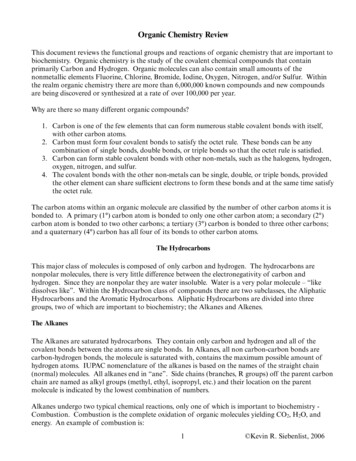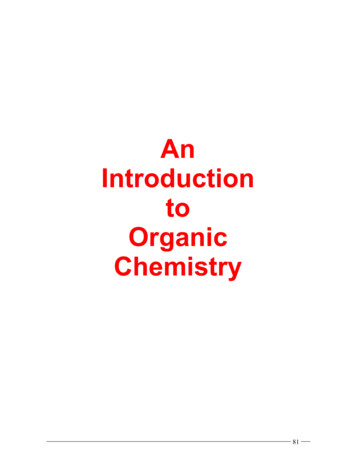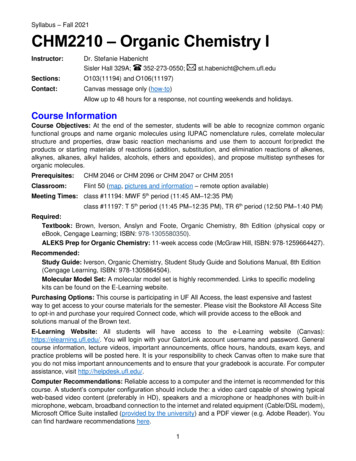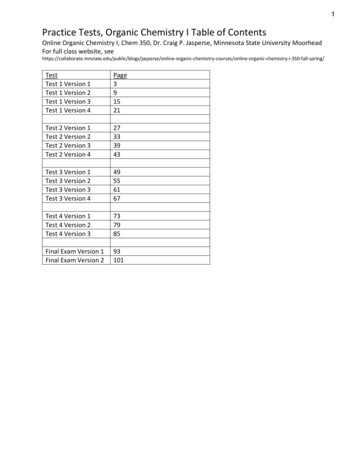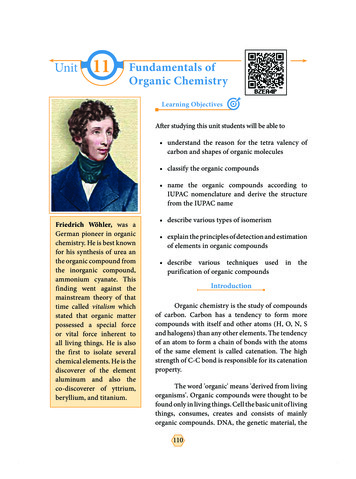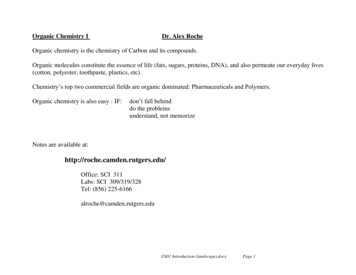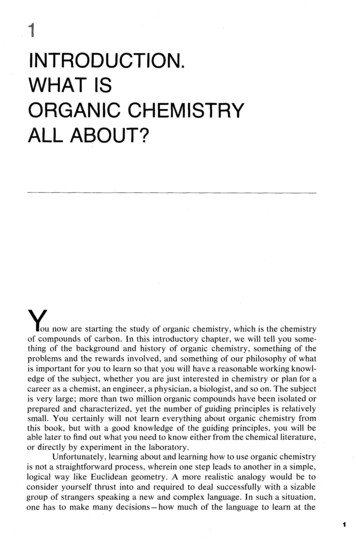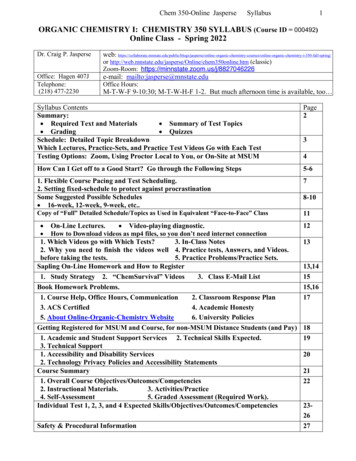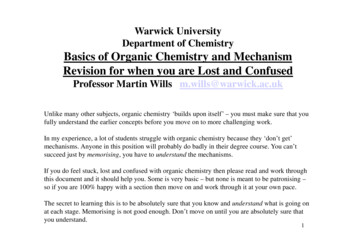
Transcription
Warwick UniversityDepartment of ChemistryBasics of Organic Chemistry and MechanismRevision for when you are Lost and ConfusedProfessor Martin Wills m.wills@warwick.ac.ukUnlike many other subjects, organic chemistry ‘builds upon itself’ – you must make sure that youfully understand the earlier concepts before you move on to more challenging work.In my experience, a lot of students struggle with organic chemistry because they ‘don’t get’mechanisms. Anyone in this position will probably do badly in their degree course. You can’tsucceed just by memorising, you have to understand the mechanisms.If you do feel stuck, lost and confused with organic chemistry then please read and work throughthis document and it should help you. Some is very basic – but none is meant to be patronising –so if you are 100% happy with a section then move on and work through it at your own pace.The secret to learning this is to be absolutely sure that you know and understand what is going onat each stage. Memorising is not good enough. Don’t move on until you are absolutely sure thatyou understand.1
Nomenclature of Organic CompoundsIUPAC has defined systematic rules for naming organic compounds.These will have already been covered in detail at A-level and willonly be mentioned briefly here.The naming system (and the resulting names) can become very long with complexmolecules, therefore this section will be restricted to simple compounds.The IUPAC naming system involves the following components:- Identification of major chain or ring- Side chains and functional groups are added asappropriate, in alphabetical order.- The sums of numbers for substituents are minimisedProfessor M. Wills2
Nomenclature of Organic CompoundsExamples:CH3H2CH2CH3CCH2CHCH2CH3CH2is 3-methyloctane,not 5-methyloctane2'major 3CHCH4H2C2CH35CH31CH3 CH3CH3CH3CIs 5-(1’-methylethyl)-2,2,4-trimethyloctane1CH3 CH3H2CCH3Is 4,5-diethyl-2,2-dimethylheptaneIt is NOT3,4-diethyl-6,6-dimethylheptane!4H3CH2C 2CH3CH314H3CH2C 2CH3OHButan-2-olCH31Cl2-chlorobutaneProfessor M. Wills3
Nomenclature of Organic CompoundsMany common names persist in organic chemistry, despite IUPAC rules, e.g.Compound‘common’ nameIUPAC c acidEthanoic H3Professor M. Wills4
Substitution level and functional groupsThe ‘substitution level’ of a carbon atom in an organic compound is determined bythe number of attached hydrogen atoms:tertiary carbon (one H)CH3H3CH2CH3CPrimary C (3 hs)CHH2CCHCH2CHCH3Secondary C (2 Hs)CH3CCH3 CH3Quaternary C (0 Hs)The rules differ for certain functional compounds e.g. alcohols:CH3H3CH2CH3CCHOHPrimary alcohol(2Hs on C attached to O)OHSecondary alcohol(1H on C attached to O)H3COHCCH3 CH3Tertiary alcohol(0Hs on C attached to O)Professor M. Wills5
Substitution level and functional groupsIn the case of AMINES, the rules are different:H3CHH3CHNNHCH3Primary amine(2Hs on N)CH2H3CNCH3Secondary amine(1H on N)Tertiary amine(0Hs on N)Aromatic compounds: substitution position relative to group ‘X’Xpara meta orthoProfessor M. Wills6
Substitution level and functional groupsFunctional groups will be dealt with as they arise, however the following should becommitted to memory:R alkyl group, joining at C atom, e.g. CH3, c-C6H11, CH2CH2CH3 OOORKetoneEsterRHRCCCCOOONAcid ChlorideRRCCarboxylic nhydrideImineORNRONitrogroupA cyclic ester is called a lactone, a cyclic amide a lactamProfessor M. Wills7
Line drawingLine drawing represents an abbreviated ‘shorthand representation of organic structures:The rules are simple- Structures are written as a series of interconnected lines where eachapex is the position of a carbon atom. Heteroatoms (i.e. not H or C) are shown. H atoms arenot shown with the exception of those on heteroatoms.ExamplesEthanolEthanalFull structureH3CAbbreviated 'line-drawing' structureOHOHOOCH2H3CCHPropeneCH2H3CN.b. in some casesthe H atom of analdehyde may beillustratedCHHBenzeneHC CHCCHC CHHProfessor M. Wills8
Oxidation levelThis is a useful tool for the understanding of organic reactions. It is slightly differentto the system used for the oxidation level of cations and anions. It is useful to know whether a reduction oroxidation takes place, because this allows a correct selection of reagent to be made.In some cases it is obvious that a reaction is an oxidation or reduction, in othercases they are not, for tion of two H atoms)CH2H3CH3C(removal of two H atoms)CH2H3CoxidationCHOxidation or reduction?(addition of O andof two H atoms)OHH2CH3CCH2OHProfessor M. Wills9
Oxidation levelTo assign oxidation number (Nox), there are a number of methods you can use however this one is easy identify each each carbon atom that changes and assign oxidation numbers as follows:a) For each attached H assign ‘-1’.b) For each attached heteroatom (O, N, S, Br, Cl, F, I etc.) assign ‘ 1’.c) Double or triple bonds to heteroatoms count double or triple respectively.Then sum them for each molecule.ExampleEthanolEthanalOHH3CCH2CHtotal -4Nox -1 (1 attached O atom, 2 attached H atoms)OH3CNox -3 (3 attached H atoms)Nox -3 (3 attached H atoms)Nox 1 (1 double bond toO atom, 1 attached H atoms)total -2A change of ‘ 2’ indicates an oxidation. A change of ‘-2’ indicates a reduction.note 2 or -2 is the typical change in oxidation level.Professor M. Wills10
Molecular Stability - covalent vs ionic bondingMany factors dictate the stability of atoms and ions. Hydrogen atoms gain stability if there are twoelectrons in their electron shell. For first and second row elements, significant stability is derivedfrom an outer electronic configuration with 8 electrons.Atoms can achieve this by i) gaining or losing electrons or ii) sharing them.In the periodic table:Central elements cannoteasily lose or gain electrons andprefer to bond covalently. These arethe most common atoms in organic compoundsHLiBeNa MgBCNOFNerow 1Al SiPSClArrow 2Atoms at theextremes of therows can gain or lose an electron toform an ionic lattice (e.g. NaCl)The simplest example is where two hydrogen atoms combine to form H2, with a covalent bondbetween the atoms:H . H.Two H atoms,1 electron each.H : HHHcovalent bond- electrons sharedProfessor M. Wills11
Molecular Stability - covalent vs ionic bondingExamples(nb the three dimensional shapes of the molecules will be discussed in a later section)Methane, CH4H.H : C : H.Combine 4 H atoms (1 outer electroneach) and 1 C atom (4 outer electrons)to form methane:HHCHHHHHCCHHEthane C2H6HCombine 6 H atoms (1 outer electroneach) and 2 C atom (4 outer electrons)to form ethane.H : C :C.HH: HHHHEthene C2H4Combine 4 H atoms (1 outer electroneach) and 2 C atom (4 outer electrons)to form ethen with double bond:HH::C :: C.HHHCHHCHProfessor M. Wills12
Molecular Stability - covalent vs ionic bondingExamples of covalent compounds – I realise that this is very basic however some people still struggle with it.It is not meant to be patronising so please move on rapidly if you are OK with this:Ethyne C2H2Combine 2 H atoms (1 outer electroneach) and 2 C atom (4 outer electrons)to form ethyne with triple bond:Methoxymethane (dimethylether)H : C ::: C : HHH. . H.:O : C : HH : C. . .Combine two C atoms (4 electrons),Hone O atom (6 electrons) and six HHatoms (1 electron). Two pairs of electrons(lone pairs) reside on the oxygen atom and the molecule has a 'bent' structure.CHCHH.H C O.CHHHMethanal (formaldehyde)HCombine one C atom, one O atomand two H atoms with a C O doublebond. There are two lone pairs on O. .C :: O :.HH.C OHProfessor M. Wills13
Molecular Stability - covalent vs ionic bondingExamples of covalent compounds:Ammonia NH3Combine 3 H atoms (1 outer electroneach) and 1 N atom (5 outer electrons)to form ammonia with lone pair on NThe molecule has a tetrahedral shape.HH.:H : N.HHN:H Ammonium cation [NH4] - an example of when an overall charge is required for stabilityCombine 4H atoms (1 outer electroneach) and 1 N atom (5 outer electrons),then lose 1 electron to form ammoniumcation with an overall positive charge.HH.H : N :H.HNHHHSame argument applies to protonated water - see if you can draw it.More complex example:H HCombine one boron (3 electrons),one Nand 6 H atoms to form a complex ofborane (BH3) and ammonia (NH3). .H : N :B:H. .H HHHHNBHHHProfessor M. Wills14
Molecules in 3D.Linear combination of atomic orbital (LCAO) model.Always remember that atomic orbitals (in atoms) combine to give molecular ones (in molecules - which isobvious) but there are some rules:i)n atomic orbitals form n molecular orbitals.ii)The combination of atomic orbitals leads to the formation of a combination of bonding,nonbonding and antibonding orbitals.iii)In a stable molecule, the antibonding orbitals are empty, which is why it is stable!e.g.HThe bond picture of dihydrogen formation: HTwo atomic orbitals (s)1 electron in each one. H.HTwo H atoms,1 electron each.This is what the orbitals do:H.: HHHcovalent bond- electrons sharedTwo molecular orbitalsHHbonding orbitallow energy( , contains 2 electrons)HHantibonding orbitalhigh energy( , empty)Since only the bondingorbital is filled, themolecule is stable.Professor M. Wills15
Molecules in 3D.Linear combination of atomic orbital (LCAO) model.This is how the energy of the orbitals would be depicted:Two molecular orbitalsH HTwo atomic orbitals (s)1 electron in each one.HHbonding orbitallow energy( , contains 2 electrons)HHantibonding orbitalhigh energy( , empty)Since only the bondingorbital is filled, themolecule is stable. one electronantibonding orbitalhigh energy, EnergyHHbonding orbitallow energy, The electrons 'drop' into a lower energy position, which provides a driving force for the reaction, and stability.Always bear this in mind when thinking about molecular orbital structure.Professor M. Wills16
Bond PolarityCovalency suggests equal sharing, but this is rarely the case because atoms differ in theirinherent ability to stabilise negative charge, I.e. their ‘electronegativity. Electronegativityincreases in the direction of the arrows shown below (for the first two rows of the periodic table):moreelectronegativeHLiBeNa MgBCNOFAl SiPSClPauling scale of electronegativity allows a quantitative comparison:e.g. H (2.1), C (2.5), N (3.0), O (3.5), F (4.0), Cl (3.0), Br (2.8), I (2.5) etc.As a result, most heteroatoms (X) are more electronegative that carbon and C-X bonds arepolarised so that there is a partial positive charge on the carbon atom.The polarityis illustrated thus:C XSee next page for examples Professor M. Wills17
Bond Polarity – although basic, it is very important because it allows us topredict where reactions will take place.Examples of covalent bonds which contain a dipole:C C ClC O C BrC OH Note: in the case of double andtriple bonds, resonance(delocalisation) effectsalso contribute to the polarity.N A few elements (notably metals) are less electronegative than C. As a result the dipoleis reversed:C Si C Mg This polarity effect is sometimes referred to as the INDUCTIVE effect, and operates throughsigma bonds in molecules (see a later section).Professor M. Wills18
Formal Charge – this is surprisingly important so make sure you understand,Formal charge is a method for assigning charge to individual atoms in molecules. Althoughit does not always give a ‘perfect’ picture of true charge distribution, it is very helpful whenreaction mechanisms are being illustrated.The definition of formal charge on a given (row 1 or 2) atom is as follows:Formal charge on atom X (FC (X)) (‘atomic group number’ of the atom* – ignore transitionmetals when counting!)-(number of bonds to the atom)- 2(number of lone pairs on the atom).(You may see a slightly different version of the equation in other places).Example:Ethane HCHHHCHHfor each (equivalent) C atom, FC(C) 4 -(4)-2(0) 0for each (equivalent) H atom, FC(C) 1 -(1)-2(0) 0Hence the formal charge on each atom in ethane is zero.N.b - use a atomic group number of ‘1’ for hydrogen.* i.e. count from 1 to 8 across the row.Professor M. Wills19
Formal ChargeFurther examples:Ethene HCHfor each (equivalent) C atom, FC(C) 4 -(4)-2(0) 0for each (equivalent) H atom, FC(H) 1 -(1)-2(0) 0HHence the formal charge on each atom in ethene is zero.CHMethoxymethane (remember this moelcule has two lone pairs on O).HHOCH. CHHfor each (equivalent) C atom, FC(C) 4 -(4)-2(0) 0for each (equivalent) H atom, FC(H) 1 -(1)-2(0) 0for the O atom, FC(O) 6 -(2)-2(2) 0HHence the formal charge on each atom is zero.Ammonium cation (overall charge of 1)HHNHHfor each (equivalent) H atom,FC(H) 1 -(1)-2(0) 0for the N atom,FC(O) 5 -(4)-2(0) 1Hence the formalcharge on theatoms in themolecule is:.HHNHHProfessor M. Wills20
Formal ChargeFurther examples:Protonated water (overall charge of 1 and a lone pair on O).HOHHfor each (equivalent) H atom,FC(H) 1 -(1)-2(0) 0for the O atom,FC(O) 6 -(3)-2(1) 1Borane-ammonia complexfor each (equivalent) H atom,H HFC(H) 1 -(1)-2(0) 0H N B Hfor the N atom,FC(O) 5 -(4)-2(0) 1H Hfor the B atom FC(B) 3-(4)-2(0) -1Methyl cation (only 6 electrons around C):Hence the formalcharge on theatoms in themolecule is:.Hence the formalcharge on theatoms in themolecule is:.COHHHHHNBHHHTetrafluoroborate anion:HHHFFBFHFUse the formal charge definition to check the last two examples (n. b. there are threelone pairs on each fluorine atom in BF4.Professor M. Wills21
Acidity of organic compoundsAcidity is a measure of the ability of a compound to ionise to a proton and a negatively charged counterion.Group. Organic compounds are not very acidic compared to strong mineral acids, however some arestronger acids than others. This is a VERY important area to understand for organic chemistry.Let’s put this into context.The relative acidity in aqueous solution of a compound is defined by its pKa.This is a measure of the inherent ability of any compound to lose a proton in an equilibrium process:forHXRKapKa - log [H ][RX ]H XR[HX]or - Log KaThink about this for a second If HXR is a strong acid, the equilibrium will be over to the right hand side. Ka will be high andpKa will be a low number (possibly even negative). Carboxylic acids, some of the strongest organicacids, have a pKa of around 5. If HXR is a weak acid he the equilibrium with be over to the left handside, Ka will be low and the pKa will be quite high. Alkanes (CnH2n 2) are very reluctant to lose aproton and are weak acids. The pKa of an alkane is around 40. Most organic compounds have pKasbetween these extremes.Professor M. Wills22
Acidity of organic compounds –it is difficult to overstate how critically important this is!Nb - a related scale, pH, is a measure of the amount of protons in a solution at any moment.pH is defined as -log [H ].Here are a few more examples of pKa values of organic compounds.Remember that each unit of pKa represents a tenfold change in acidity.Some examples (no. relates to circled proton) are given ssor M. Wills23
Molecules in 3D.Rehybridisation and VSEPR:The three-dimensional structure of organic compounds often influences their properties and reactivity.Each carbon atom in an organic molecule can be linked to four, three or two other groups. In each casethe orbital structure and three-dimension shape around that carbon atom is differentIn the case of a carbon atom attached to four other groups by single bonds, the single 2s and the three2p orbitals gain stability by mixing (rehybridisation) to form four sp3 orbitals. These are all arrangedat mutual 109.5 degree angles to each other and define a tetrahedral shape:1 x 2s3 x 2pcombine to form 4 x sp3:on a carbon atomHCwhich lie at mutual 109.5 degreesin a molecule such as methane, CH4:HHCHHHHHA tetrahedral shape is favoured because this maximises the distance between the filled orbitals, whichcontain negatively charged electrons, and therefore repel each other. This is known as the ‘valence shellelectron pair repulsion’ (or VSEPR), and often dominates the shape of molecules.Professor M. Wills24
Molecules in 3D.The VSEPR model for the structure of molecules also explains why molecules such as ammonia andwater are not flat or linear respectively. Their structures are ‘bent’ because of repulsion effect of theelectrons in the lone pairs (which are in sp3 orbitals).At the nitrogen atom in ammonia, NH3:1 x 2s3 x 2pcombine to form 4 x sp3:on a nitrogen atomlone pairorbitalsN.which lie at mutual 109.5 degreesin the ammonia molecule, NH3:H HHHNHAs a result, ammonia is tetrahedraland has a significant dipole. HAt the oxygen atom in water, H2O:1 x 2s3 x 2pcombine to form 4 x sp3:on an oxygen atomOlone pairwhich lie at mutual 109.5 degreesin the ammonia molecule, NH3:orbitals. HHH HO:As a result, water is tetrahedraland has a significant dipole.lone pairProfessor M. Wills25
Molecules in 3D.Some things to be aware of:i)Symmetrical, tetrahedral, compounds have no overall dipole:HFor example in the ammonium cation, NH4 H H NH The shape is still tetrahedral, and eacn N-H bond has adipole, but there is no overall dipole, because theycancel out.HFor the same reason, methane has no overall dipole either:CHHii)HMolecules which are electron deficient, such as borane (BH3), retain a trigonal shape. Why? –Well, without an electron pair, there is nothing to repel with!!!Borane, BH3:HHB(one B atom with three electronsand three H atoms with one electroneach form borane, which has only 6electrons at the B atom:HFlat (trigonal), 120o bond anglesno overall dipoleHHBHH::B: HHBIn contrast, borohydride anion,NH4-, is tetrahedral, with no overall dipole:HHHBHHH(3 sp2 orbitals and one p orbital,orthogonal to plan of BH3 atoms)Professor M. Wills26
AlkenesIn the case of a carbon atom attached to three other groups (by two single bonds and one double bond)the single 2s and two 2p orbitals mix (rehybridise) to form three sp2 orbitals. These are all arranged atmutual 120 degree angles to each other and define a trigonal shape, the remaining p orbital projects outof the plane of the three sp2 orbitals and overlaps with an identical orbital on an adjacent atomto form the double bond:1 x 2s2 x 2pon a carbon atomcombine to form 3 x sp2 orbitals:Cwhich lie at mutual 120 degreesHin a molecule such as etheneC2H6,whilst the remaining p orbitalforms the double bond:HHHHCCHHHThe resulting structure is rigid and cannot rotate about the C C bond without breakage of thebond between the p-orbitals (the p bond). The can be separated into E and Z configuration isomers.The p bond is much more reactive than the s bond – the bonds are not equivalent to each other.Prof M Wills27
Alkynes:In the case of a carbon atom attached to two other groups (by one single bonds and one triple bond)the single 2s and one 2p orbitals mix (rehybridise) to form two sp orbitals. These are all arranged atmutual 180 degree angles to each other and define a linear shape, the remaining p orbitals projecting outfrom the sp orbital to overlap with identical orbitals on an adjacent atom to form the triple bond:1 x 2s1 x 2pcombine to form 2 x sp2 orbitals:on a carbon atomCwhich lie at 180 degreesin a molecule such as ethyneC2H4,Hwhilst the remaining p orbitalsform the triple bond:HHCCHRehybridisation of orbitals of this type is not limited to carbon, of course. Many other row 1 and 2atoms (notably N) can rehybridise within organic molecules.Both p bonds in an alkyne are much more reactive than the s bond.Prof M Wills28
Molecules in 3D Conformation and configurationConfiguration is a fixed stereochemical property of compounds. Unlike conformation, a changein configuration requires bonds to be broken and formed. Any molecule has a limited number ofconfigurations in which it can exist.Alkenes can exist in two configurations, for example but-2-ene may have the terminal methyl groupsin a trans (across from each other) or cis (on the same side) position:HH3CCtrans-but-2-eneHH3Ccis but-2-eneCCH3CH3CHCHChanging trans butadiene into cis- butadiene (or vice versa) requires the breaking, andsubsequent reforming, of the p bond. This is a high- energy process and does not take placeat room temperature. At room temperature, but-2-ene (and other alkenes) can be physicallyseparated into the two pure isomers.Professor M. Wills29
Molecules in 3D - Conformation and configuration: E and ZThe configuration of an alkene can be obvious in some cases (such as but-2-ene) however in othersit is not, for example is the molecule below a cis or trans alkene?H2CH3CCHCH3CCH3In order to provide an unambiguous means for assigning configuration to alkenes (and also tochiral centres as you will see later), organic chemists have adopted the ‘Cahn-Ingold-Prelog’ (CIP)rules for configurational assignment.These are simple to use - first one assigns a ‘priority’ to each group attached to each carbon atom ateach end of the alkene. I will describe to priority rules in the next slide. We then define the alkene aseither Z (from the German zusammen, together) or E (from the German entgegen, across):HighHighCZ alkene:LowCE alkene:CLowHighLowHighCLow(relative priorities are of a group on a C atom to its partner on the same atom)Professor M. Wills30
Molecules in 3D Conformation and configurationThe CIP priority rules are defined as follows, in their own order of priority:a) Atoms of higher atomic number have priority:CH3H3Ce.g.CCCHHHighHighCHHIn this molecule the attached carbon atoms at each end of the double bondhave priority over the attached H atoms, hence this is a Z alkeneb) When the attached atoms are identical on each side, isotopes of higher mass have priorityDH3Ce.g.CHHighHighCCHHCHIn this molecule the attached carbon and deuterium (deuterium is the H-2 isotope)atoms at each end of the double bond have priority over the attached H atoms, hencethis is a Z alkeneProfessor M. Wills31
Molecules in 3D - Conformation and configurationThe CIP priority rules are defined as follows, in their own order of priority:a) When the atoms and isotopes attached on each side are identical, move out until a point ofdifference is encountered and apply the following rules:a) Priority goes to the group with the element of highest atomic number at the point of ighE alkeneb) Priority goes to the group with the highest sum of atomic numbers if the atoms are of thesame types at the point of difference. In the example below, the point of difference on the right handside is two carbons away from the alkene carbon E alkeneH2CCH3Professor M. Wills32
Molecules in 3D - Conformation and configurationThis is how I worked out the last example (right hand side only):Imagine you are moving out from the C tothe adjacent atoms. Going both up (to C1) and down(to C1') leads to a CH2 group, i.e. no difference. Moving to the next atom reveals that C2 (topbranch) is attached to C,C,H but that C2' (lower branch) is attached to C,H,H. The upper branch hasthe highest sum of attached atomic numbers and therefore has priority.1 2H2C CHHCH3CC H2C1'CH3CH32'CH2H2CUpper: C - C1(C,H,H) - C2(C,C,H)HighLowCLower: C - C1(C,H,H) - C2(C,H,H)H2CCLowHighE alkeneCH3There is one more rule:d) In the case of double and triple bonds, ‘dummy’ atoms should be added and counted in thedetermination of priority. See next slide.Professor M. Wills33
Molecules in 3D - Conformation and configurationHere is an example of the determination of configuration for an alkene attachedto a double bond:C1HCHCH3CC H2C1'1CH2HCH2C2'CH2H2CC H2CH3CH2CC2CH22'CH21'CH3H2C --dummy atomsUpper: C - C1(C,C,H)H2 Lower: C - C1(C,H,H)CCH3HighLowCCLowHighE alkeneProfessor M. Wills34
Molecules in 3D - Conformation and configurationCIP priority rules are also applied to the determination of configuration at chiral centres (a chiralmolecule is one which is not superimposable on its mirror image, rather like your hands). The simplestform of a chiral centre is one with a carbon atom attached to four different groups.E.g.mirrorCBrClFH isa chiral moleculethe two forms (knownas enantiomers) canbe illustrated thus:FClFCCBrHHClBrTo assign a configuration to a chiral molecule such as the one shown above we first assignCIP priorities to all four groups using the same rules:e.g.FClBrCH3211 highest priorityto 4 lowest priority.C4Professor M. Wills35
Molecules in 3D - Conformation and configurationWe then view the molecule, with the assigned priorities, along the C-4 bond (with the 4 behind the centralcarbon atom. Finally, draw an arrow from atom with priority 1 to priority 2 to priority 3 in turn:32132atom 4 is behind CCC41In this case the arrow is clockwise; this is therefore referred to as a R isomer (R comes from the Latinrectus, for ‘right’). Isomers of this type are sometimes called ‘enantiomers’.FClBrR enantiomerCHThe mirror image of the molecule above is the S enantiomer (from the Latin sinister for ‘left’)3FCHClBrC4213C2S enantiomer1Professor M. Wills36
Molecules in 3D - Conformation and configurationHere are a couple of examples - can you see the derivation of the configuration?H2N34 3H CH3SH2R configuration1234 3H CH3H2NSH11S configuration212One carbon atom makes all the difference!Professor M. Wills37
Molecules in 3D - Conformation and configuration: don’t get confused between L/D, l/d and R/S!This is very important – please read it.Some other conventions are used to defined the configuration at chiral centres e.g.l - molecule with a negative optical rotation (from the Greek for levorotatory; left)d - molecule with a positive optical rotation (from the Greek for dextrarotatory; right)The D/L notation ( a very old convention) is derived from the signs of optical rotation of R and Sglyceraldehyde respectively:HO HH OHHOHOCHOD ( )-glyceraldehyde (also R)CHOL (-)-glyceraldehyde (also S)The trivial convention for the absolute configurations of sugars derives from the D/L notation above.D-glucose is the natural enantiomer (costs 20/kg) whilst L-glucose is very rare ( 31/g!).Professor M. Wills38
Molecules in 3D - Conformation and configurationAmino acids are classified into L- (natural) and D- (unnatural)R HH RH2NCO2HL - amino acidH2NCO2HD- amino acidMost L-amino acids are of S- configuration.Despite all the different notations, R and S is the one YOU should learn how to use.Professor M. Wills39
Molecules in 3D - Conformation and configurationThe two mirror-images of chiral compounds can have dramatically different physical properties.That is because we ourselves are made up of molecules of one ‘handedness’. Try assigning R/S to these:OONHiPrOOHNHiPrCO2HOHCO2HNH2HSOEt OClEt ONClNOEtONHNOONHThalidomideR is mutagenicS is anti-emeticPenicillamineR is an antiarthriticS is a highly toxicPropranolol:R is a heart drugS is a contraceptiveLimonene:R has a lemon odourS has an orange odourNNH2HSOCO2HCO2HOEt'Dual'R is an herbicideS is a pesticideIbuprofenR is anti-inflammatoryS is inactiveProfessor M. Wills40
Examples of drugs containing a chiral centre:FHNNNHOMe2NNNCNH .HClNCF3OHNCinacaletHydrochloride(Amge, 2OOCF3NFONHtBuLY2497282(Eli Lilly, diabetes)Aprepitantanti emeticHNNFLevetiracetam(UCB Pharma.antiseizure)OOHNOLacosamideNHBn (antiepileptic)MeONHAc41
Mechanism and ‘arrow pushing’. - you must understand this!This is a very important section which deals with the mechanism by which one molecule is converted intoanother. It is a means of showing the way electrons (which make up bonds) move when one compound istransformed into another. ‘Arrow pushing’ is employed to illustrate mechanisms in organic chemistry.e.g. consider protonation:HHHHN: HHHNHIn this process, the lone pair of electrons on N has become a bonding pair in the product.This is how we would show the reaction with a curved mechanistic arrow :HHHHN:HHHHHNHorHHN:HHHNHProfessor M. Wills42
Mechanism and ‘arrow pushing’ – protonation and deprotonation.The definition of formal charge means that ‘arrow pushing’ also shows the movement offormal charge during a reaction.During protonation, the formal charge moves from the proton (H ) to the nitrogen atomHHHHN: HHHNHThis makes sense because, in the protonation, the nitrogen has donated a full pair ofelectrons but in the product shares a bonding pair, a net loss of 1 electron. The proton (H ),on the other hand, had no electrons originally but now shares a bonding pair, a net gain ofone electron (hence the drop in charge from 1 to 0). We represent this movement of anelectron pair as a ‘curly arrow’ – NOTE THE DIRECTION OF FLOW!N: net loss 1 electronH: net gain 1 electronHHHN:HN atom formal charge 0H formal (and actual) charge 1HHHN:HNote that the lone pairon nitrogen becomes thebonding pair in the N-Hbond.N atom formal charge 1H formal charge 0Professor M. Wills43
Mechanism and ‘arrow pushing’ – protonation and deprotonation.Now lets look at the reverse direction, i.e. deprotonation:HHHHNHHHN: HThe formal charge has moved from N to H. This is because the H was sharing an electronpair on the left hand side, but has none on the right hand side, a net loss of 1 electron.This is how we would show the reaction with a curved mechanistic arrow - note how itshows the bonding pair moving out of the bond and towards the N atom :HHHHNHHHN: HIn reality, a proton is usually removed by a base. This is how it would be illustrated:HHHHNHOCH3Methoxide, actingas a base.HHN: HOCH3The f
Department of Chemistry Basics of Organic Chemistry and Mechanism Revision for when you are Lost and Confused Professor Martin Wills m.wills@warwick.ac.uk Unlike many other subjects, organic chemistry ‘builds upon itself’ – you must make sure that you fully understand the earl

